
Considering Physical Space in Museum-Based Mobile Learning
Editor's Notes
- This is an optical illusion exhibit from the Exploratorium, a children's science center in San Francisco. It presents a great metaphor for the issues that I'm talking about today. Perhaps some of you have seen this type of illusion before, but in any case - We have these columns, these architectural features that are literally defining people through their negative space. But for the purposes of this metaphor, we have visitors that are defined and supported by these physical features. But where do Mobile Phones come in to play? I'll get to that in a moment.
- So for a quick theoretical background. Falk and Dierking's contextual model of learning is a foundational theory of learning in museums. You have these three contexts with which to look at learning interactions: the physical, the personal, and the sociocultural.
- Now Falk and Dierking include the mobile phone in this physical context. "Utilizing the Contextual Model of Learning framework, personal handheld devices represent a part of the physical context of the visitor." (Falk & Dierking 2008)
- I'm going to make one change and consider the phone as a mediating tool that helps learnings navigate all of these contexts. -Interacting with each other through the phone, recording one's own knowledge, or navigating the physical space- This physical space is what I'm interested in.
- So back to the illusion exhibit.
- We have this personal element.
- This social element.
- And the physical element.
- And the mobile phone is relevant to all. So now I'd like to look at a few studies of both spatial effects on learning and mobile learning in museums and bring them together to raise a few questions.
- Sue Allen at the Exploratorium found that museum visitors would very rarely recognize the larger themes in collections of exhibits.
- However, She found that by simply putting walls around an exhibition, visitors would interpret these themes - they'd recognize the connections.
- A related study by Psarra looked at museum spaces - the layouts and ways we can move through them shape the narratives we create. Psarra was looking at art museums. So the sequences that we experience these art works - chronological, thematic, etc shape the narrative we create linking these exhibits together. The space contributes to these understandings by affording certain pathways. Ok, so that's two examples of spatial features shaping narrative experiences.
- Here we noticed that the one controlling the phone would lead the group through the space. This makes sense but what are the implications for learning in the group? Again, how can the space support the role of leader or follower?
- But mobile phones can do this to. There are several projects that let museum visitors record digital artifacts to create narrative experiences in museums. Pictures and videos that can be reflected on after as a recreation of a visit. So the question is - If we know we can design spaces to support this type of understanding. And we can also design mobile learning interactions to do the same. How do we bring these two together? How can the physical features of a space coordinate with mobile interactions? ok, one last example. At the University of Oslo, I've been involved with this project called GIDDER. Students visit an art museum, and work in small groups to make mobile blog posts (texts, pictures, etc) of their questions and interpretations of exhibits. So This girl turned her back on the exhibit to make a post. She wasn't the only one to do this either. But maybe there is this need to separate one's self from the exhibit in order to reflect on it. Maybe spaces can be designed to support this reflection - break away space, a mobile learning booth like a phone booth.
- And then Finally we have a nice image to justify thinking of phones as a mediating tool - as a lens through which the exhibits are experienced.
- So just to reemphasize the concluding question - As we move forward designing new mobile learning interactions, how can we design museum spaces that support and are enhanced by mobile learning?